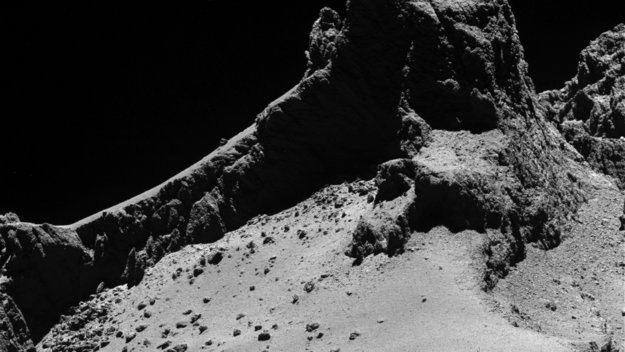|
|
The Surprise Look of a Comet: First Results from Rosetta
24 January 2015
Rosetta is revealing its host comet as having a remarkable array of surface features and with many processes contributing to its activity, painting a complex picture of its evolution.EIRNS—The first observations made by Europe’s Rosetta spacecraft, discussed in articles published in this week’s issue of Science magazine, are just what you would expect—the unexpected. Seven scientific articles discuss some of the major findings, based on observations from seven of Rosetta’s 11 instruments. These data are just the first batch, and may well need to be reinterpreted as Rosetta travels alongside comet 67P/Churyumov-Gerasimenko for the next few months, quickening its rate of change, as it heads toward the Sun. Overall, the structure and composition of the comet are more complex than expected, its out gassing of volatiles (gases) are more variable, and it is still a mystery as to what its evolution has been, over time. So far, about 70% of the comet’s surface has been imaged by the OSIRIS camera. The remaining 30% is currently in darkness. The photos have revealed a remarkably complex and dramatic surface, with areas that are covered in dust, some large-scale depressions, smooth terrains, rocky surfaces, and pits and circular structures. Scientists, at this point, are still not sure whether comet 67P/C-G formed all at the same time, or was formed by the fusing of two or more separate objects.
The scientists have so far identified 19 regions separated by distinct boundaries and, following the ancient Egyptian theme of the Rosetta mission, these regions are named for Egyptian deities, and are grouped according to the type of terrain dominant within.Scientists had assumed that a comet’s coma, formed from the out gassing of material in the nucleus, grew steadily and was homogeneous, made up basically of water and dust. "From a telescope, images of a comet’s atmosphere suggest that the coma is uniform and does not vary over short periods of hours or days," said Dr. Stephen Fuselier, a co-investigator on one of Rosetta’s spectrometers. But day/night variations in the rate of out gassing that forms the coma were observed, and seasonal variations are also a possibility. In composition, "the coma sometimes contains much more carbon dioxide than water vapour," he said. And as it draws closer to the Sun and warms, with August 13th the closest approach before it heads back out past Mars, the comet’s rate of change will increase. As the coma made up of gas and dust grows, its interaction with the charged particles in the solar wind and with the Sun’s ultraviolet light, will create an ionosphere (region of charged particles above the surface) around the comet, and eventually, a magnetosphere, which magnetic field will itself interact with that of the Sun. Marsha Freeman |



